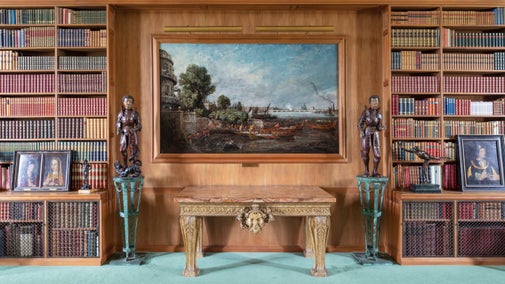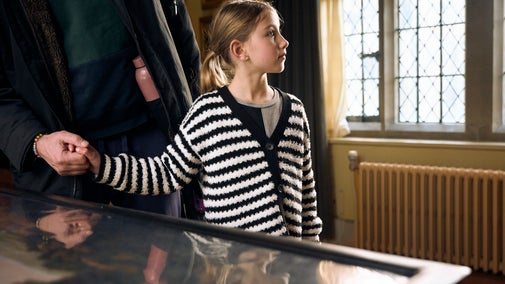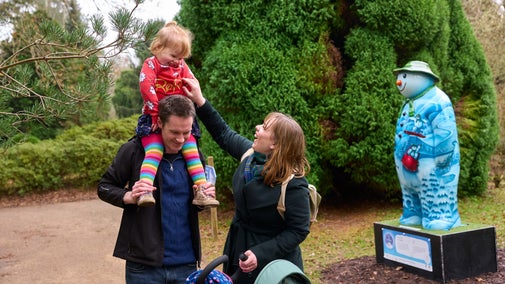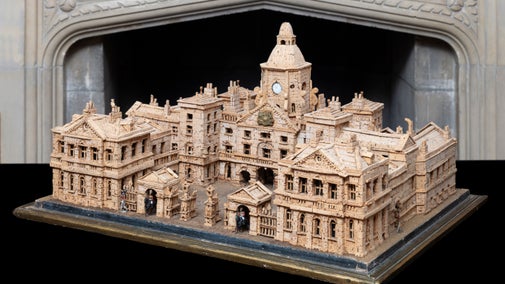
Anglesey Abbey and Lode Mill's collections
Explore the objects and works of art we care for at Anglesey Abbey and Lode Mill on the National Trust Collections website.

The National Trust looks after a treasure chest of history. From artistic masterpieces and vast tapestries to precious personal possessions, the range and breadth of the collections is astonishing. The BBC TV series 'Hidden Treasures of the National Trust' shares the stories behind some of these remarkable objects. Discover more about some of the treasures in the Anglesey Abbey collection that you can see when you next visit.
This spectacle has delighted people since the early 1800s. In the shape of a pagoda, the clock not only tells the time but also puts on an automated spectacle at midday: a tune plays upon 12 bells, while three jewelled pineapple plants on each tier of the pagoda lift from their pots and spin around. You can watch the clock in action here.
The Pagoda clock has recently been repaired by our Horologist and features in series 2 of the BBC's 'Hidden Treasures of the National Trust'.

Five of these shields were made in silver gilt between 1819 and 1824, all of them considered masterpieces of Regency silver. This shield, which is currently on display in the house, was bought by Lord Fairhaven in the mid-20th century. It has a central scene of Apollo driving the chariot of the sun, surrounded by symbolic representations of constellations. There is also a broad frieze with a series of scenes from the Iliad, bordered by a narrow band of waves representing the ocean.
Discover more about the Shield of Achilles
This tapestry, woven from wool, silk and metal threads, was commissioned by Lord Fairhaven in 1934. The Cambridge Tapestry Company, who made this tapestry, operated during the early 1900s but used techniques from the 1600s. By the 1930s the company was struggling financially. Lord Fairhaven supported the company with accounting and by commissioning this tapestry. Anglesey Abbey is shown surrounded by Cambridgeshire landmarks, thereby placing it at the heart of the local landscape.

Thomas Gainsborough is one Britain’s most loved artists. The Suffolk-born painter is best known for his society portraits which brought him commercial success, but his landscapes were highly influential in establishing the genre. Lord Fairhaven filled his home with English landscape paintings. Mettingham Castle is around 13 miles from the Suffolk coast and looks very different to the ruin in this imagined landscape.
A carved and painted limewood sculpture of the former Saint Christopher is displayed in the Dining Room at Anglesey Abbey. The story of the giant Christopher carrying Christ across a river is depicted in this excellent example from the school of limewood sculpture that centred around Ulm, South Germany, from around 1450 to 1525. Christopher talismans remain popular with travellers to this day.

Explore the objects and works of art we care for at Anglesey Abbey and Lode Mill on the National Trust Collections website.
Discover the many layers that Anglesey Abbey has to offer. A Jacobean priory, once home to Lord Fairhaven.

Discover the many layers that Anglesey Abbey and Mill has to offer and explore the long and fascinating history that stretches from 12th-century priory to 20th-century home.

Every day important conservation work takes place throughout Anglesey Abbey, in the house, gardens and Lode Mill. Take a look at what this involves and why we need your support to look after this special place.

Plan your next family adventure at Anglesey Abbey.

The art and heritage collections we care for rival the world’s greatest museums. Learn more about the collection of paintings, decorative art, costume, books, household and other objects at historic places.

See the breadth of our collection of works of art, furniture and more: we care for around a million objects at over 200 historic places, there’s a surprise discovery around every corner.

Discover the stories behind some of the greatest artworks and artefacts looked after by the National Trust, as told in a dedicated book, 125 Treasures from the Collections of the National Trust.
